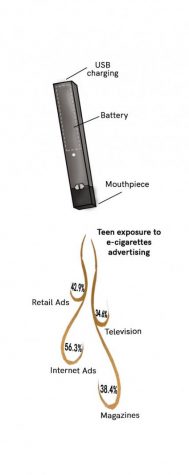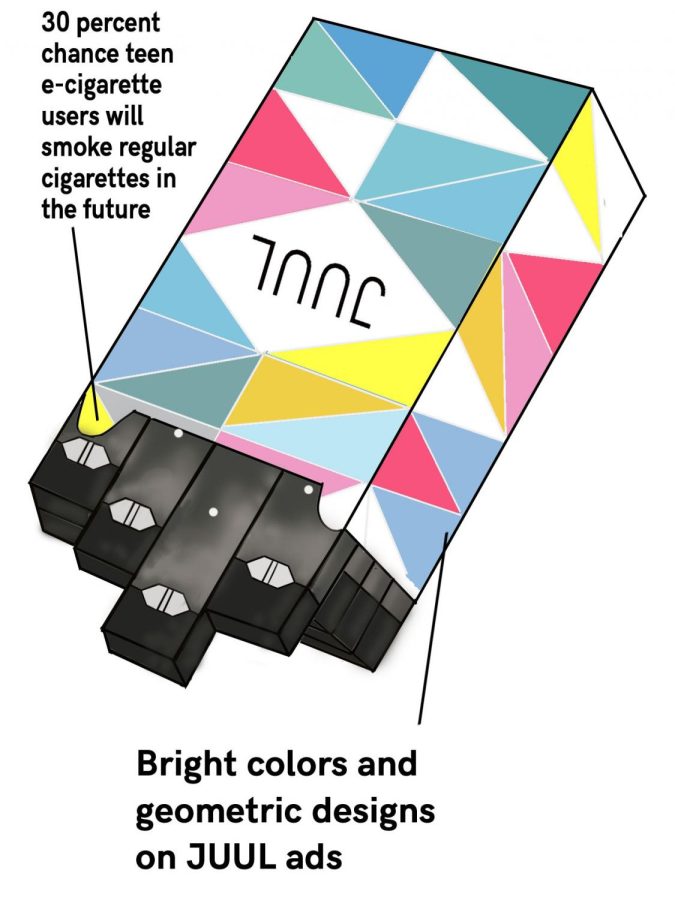Rising teen use, dangers of JUULs cause concerns
Graphic illustration of JUULs in a brightly-colored box reminiscent of a traditional cigarette box. Information about JUUL is also shown.
October 2, 2019
According to the Center for Disease Control and Prevention, in the early 2000s, adolescent smoking reached new lows due to realization of the health hazards of nicotine and tobacco within communities. However, with the rise of new technology such as e-cigarettes, teen smoking has began to skyrocket again, with the number of teen smokers increasing from 2.1 million in 2017 to 3.6 million in 2018. JUUL, a multi-million dollar company that sells flavored e-cigarettes, has become so popular that the company’s name has widely been used as a verb to describe the act of using an e-cigarette: juuling.
The JUUL e-cigarette, a sleek, USB drive-shaped device, converts liquid nicotine stored in a “pod” into a vapor that the user inhales. According to the official JUUL website, the device began as a means of “improving the lives of the world’s one billion adult smokers by eliminating cigarettes.” The company’s website also emphasizes that it provides the tools, referring to e-cigarette usage, necessary to reduce or eliminate their consumption of nicotine if they choose to. One of the key features in JUULs is their high nicotine content, with twice the nicotine of comparable devices, making it easier for cigarette smokers to transition from regular cigarettes to e-cigarettes. However, this high nicotine content also contributes to high addiction rates; smoking one pod equates to one pack of twenty cigarettes, or two hundred puffs. In addition, Juul pods come in a variety of flavors, from mint to creme brulee; there are also different types of e-cigarettes, including those that track usage of the device by connecting to apps via bluetooth.
JUULs function by heating the liquid inside the JUUL pods and creating an aerosol that carries the nicotine in the liquid to the consumer. Unlike traditional cigarettes that are set on fire, JUULs have a small wick inside the JUUL pod that heats the liquid. This difference between setting on fire and heating has contributed to the belief that e-cigarettes are generally healthier than traditional cigarettes. However, new research is refuting this belief and instead claim that e-cigarettes have almost as many, if not as many, health risks when compared to traditional cigarettes.
“In terms of heart disease risk, they are about as dangerous as a cigarette: they mess up your blood platelets which affect blood clotting, they mess up the ability of your arteries to dilate to get bigger when they need to, and they have nicotine which over a long period of time increases heart disease risk,” said Stanton Glantz, professor of Medicine in the Division of Cardiology and director of the Center for Tobacco Control Research and Education at the University of California, San Francisco. “So, they are actually looking worse than cigarettes.”
In addition, according to the Consumer News and Business Channel (CNBC), lung disease related to vaping has sickened at least 805 people across the U.S. and there have been at least 13 vaping related deaths as of Sep. 30, 2019. The study also reports a 30 percent chance that teen e-cigarette users will smoke regular cigarettes in the future, compared to the eight percent chance of teenage non-users.
But despite the research showing the many health risks and ineffectiveness of e-cigarettes in smoking prevention, JUUL has accomplished their goal of stopping adult users from smoking traditional cigarettes, to an extent. The results of a United Kingdom study, published in the New England Journal of Medicine, show that e-cigarettes and counseling were more helpful than nicotine replacement therapies such as patches and gum. These users had a median age of 41, though, so the results of using e-cigarettes at this age may be different than those in users of other ages, such as teenagers.
“Everyone wants to ban JUUL,” said Julius Wang*. “But, I don’t think banning JUUL as a corporation is effective at all because JUUL as a corporation is actually providing benefits to society, in a way, because JUUL is working to reduce the amount of people that smoke cigarettes.”
JUUL claims that its product is less dangerous than traditional cigarettes, sparking controversy over their marketing strategies and false advertising. Many assert that JUUL unfairly promotes sales of their product by making false claims about its effect, diminishing its negative impact on health and overstating JUUL’s ability to help cigarette users quit.
“Those claims are illegal,” Glantz said. “If they want to put in a claim saying that they’re less dangerous than cigarettes, they have to put in an application [to the Food and Drug Administration] that goes through a review process. Secondly, if they want to put in a cessation claim, if they want to say that JUULs will help you quit smoking… that is a therapeutic claim that has to go through a review process, too. No e-cigarette company has submitted an application or got approved.”
In addition to the health and legal concerns, JUUL is having an increased direct impact on adolescents and in schools. Atypical classroom behavior among students who use e-cigarettes is increasing day-by-day.
“I do think students leave class to vape,” said Assistant Principal Kathleen Sullivan. “I think there are students who do that and we’ve caught students doing it.”
The administration is not the only ones who have noticed the trends; students, too, have seen a rise in juuling in their peers.
“The bathrooms here smell like cotton candy, and that’s because people juul [in them],” Wang* said.
Many schools around the U.S. have begun to fight back against this growing problem. At Arrowhead Union High School in Hartland, Wisconsin, devices were installed in the bathrooms to detect vaping and would automatically send alerts to the associate principal. Schools in the Channing district, Texas, required students to roll up their sleeves when entering school to prevent them from hiding e-cigarettes. One school in Alabama has even removed bathroom stall doors.
“We do have a drug program we can send them to,” Sullivan said. “So that’s probably what we would do, depending on the nature of the situation.”

Despite JUUL’s explosive growth in use and sales, with the number of young adults from ages 18 to 21 who tried JUUL increasing more than 400 percent since being founded in 2017, the company has recently been received with reprimand across the nation. In a lawsuit filed by state prosecutors in Lake County, Illinois, in August 2019, JUUL was accused of violating the Racketeer Influenced and Corrupt Organizations Act. Specifically, JUUL was accused of using targeted advertising with catchy, teen-oriented themes, social media campaigns and candy flavoring. Their strategy, the lawsuit claims, was to get as many teens addicted to nicotine as possible through their ad campaigns, and then exploit that addiction in the long-term, as the teens would continue to buy their product. Recently, JUUL CEO Kevin Burns stepped down and a former executive from Altria replaced him, and the company confirmed it was going to reduce its staff.
Although most lawsuits and newspaper stories have been pointing fingers at JUUL, some say that the company itself may not be truly the root of the problem. Even if JUUL goes out of business, it is highly likely some other company might develop an even more advanced e-cigarette.
“[The vaping business] is simple, but it’s big money, right?” Sullivan said. “I think that another company will just pick it up.”
JUUL and companies like it have created a demand for e-cigarettes, and as long as there is demand and opportunity for profit, a company is likely to rise to match it.
“There are a bunch of third-party manufacturers that people get their e-cigarettes from,” Wang* said. “And the third-party manufacturers are never mentioned in the media.”
In the past few years, there has been an increased awareness around the detrimental effects of e-cigarettes. JUUL, as a company, has also realized the critical nature of the rising addiction rates among teenagers, and has been actively working toward preventing the use of its products among teens. Some of the company’s actions toward this cause include the strict enforcement of age verification in order to buy the company’s products —people have to be at least 21 to buy the product, as part of the Tobacco 21 initiative — and the deletion of almost all U.S.-based social media posts relating to the company and its e-cigarettes. With such measures, it hopes to reorient its marketing toward older users and rebrand itself as a product for adults only.
When the verdict on the lawsuit comes out, the community perception of e-cigarettes is bound to change, either in favor or against the use of e-cigarettes, like the opinions regarding cigarettes in the 2000s. Though the e-cigarettes were initially created with the intention as a healthier alternative to conventional cigarettes, this surge in popularity, especially among the teenagers, can have detrimental effects on the health of the future population.





































































